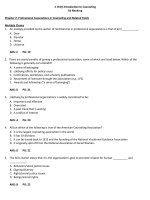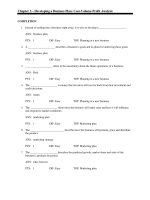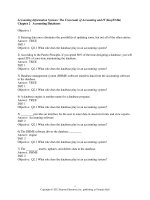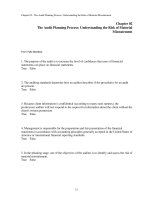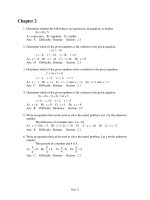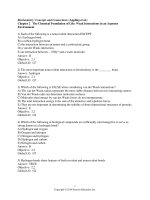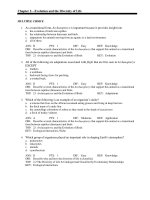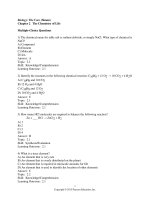Experience communication 1st edition child test bank
Bạn đang xem bản rút gọn của tài liệu. Xem và tải ngay bản đầy đủ của tài liệu tại đây (166.74 KB, 19 trang )
Chapter 02 - Communicating Verbally
Chapter 02
Communicating Verbally
True / False Questions
1. According to the textbook, using language to convey meaning is known as verbal
communication.
TRUE
Blooms: Remembering
Topic: Functions of verbal communication
2. When I tell you that reality is an enemy, I am using alliteration.
FALSE
Blooms: Applying
Topic: Functions of verbal communication
3. A friend of yours is talking about a relationship, and he says, "I don't want to get burned
again." He is using a metaphor.
TRUE
Blooms: Applying
Topic: Functions of verbal communication
4. A coffee advertisement claims that "Good coffee is like friendship; rich and warm and
strong." The advertisers are using a simile.
TRUE
Blooms: Applying
Topic: Functions of verbal communication
2-1
Copyright © 2015 McGraw-Hill Education. All rights reserved. No reproduction or distribution without the prior written consent of
McGraw-Hill Education.
Chapter 02 - Communicating Verbally
5. In describing a small automobile accident, your friend says, "I was helpless. I was knocked
out for what seemed like hours. I thought I would be left to die." She is using hyperbole.
TRUE
Blooms: Applying
Topic: Functions of verbal communication
6. If I say "Dan's dog drooled all over after drinking dirty water in the dam," I am using
alliteration.
TRUE
Blooms: Applying
Topic: Functions of verbal communication
7. According to your textbook, verbal communication serves many functions, including the
obfuscating function, which is the function to confuse others.
FALSE
Blooms: Understanding
Topic: Functions of verbal communication
8. The social function of verbal communication is the use of language to engage in critical
thinking to evaluate and critique issues or ideas.
FALSE
Blooms: Understanding
Topic: Functions of verbal communication
9. The two processes for interpreting messages are denotation meaning and connotation
meaning.
FALSE
Blooms: Remembering
Topic: How words communicate
2-2
Copyright © 2015 McGraw-Hill Education. All rights reserved. No reproduction or distribution without the prior written consent of
McGraw-Hill Education.
Chapter 02 - Communicating Verbally
10. The agreed-upon meaning of a word, the one generally found in the dictionary, is known
as the denotative meaning.
TRUE
Blooms: Remembering
Topic: How words communicate
11. Verbal communication includes a number of rules including rules of place.
TRUE
Blooms: Understanding
Topic: Rules of verbal communication
12. If you shift from one treatment of language to another based on the person or persons to
whom you are speaking, you are engaged in turn taking.
FALSE
Blooms: Remembering
Topic: Rules of verbal communication
13. The book suggests a number of categories of words to avoid—in particular, literary
language used generally by poets and writers of classical works.
FALSE
Blooms: Remembering
Topic: Words to avoid
14. Language that denigrates people on the basis of their gender is known as racist language.
FALSE
Blooms: Remembering
Topic: Words to avoid
2-3
Copyright © 2015 McGraw-Hill Education. All rights reserved. No reproduction or distribution without the prior written consent of
McGraw-Hill Education.
Chapter 02 - Communicating Verbally
15. The book suggests that using profanity is perfectly acceptable today, but using slang is not
a good idea.
FALSE
Blooms: Understanding
Topic: Words to avoid
16. If you tell a friend that you will "BRB"—by which you mean that you will be right back—
you are using jargon.
TRUE
Blooms: Applying
Topic: Words to use carefully
17. When a relative is lunching with you and says, "I have to go to the little girl's room," she
is using jargon.
FALSE
Blooms: Applying
Topic: Words to use carefully
18. If you want to improve your verbal communication, you should avoid asking the other
person, "What did you mean?"
FALSE
Blooms: Understanding
Topic: Strategies to improve verbal communication
19. One suggestion from the book for improving your verbal communication is to use
concrete language.
TRUE
Blooms: Remembering
Topic: Strategies to improve verbal communication
2-4
Copyright © 2015 McGraw-Hill Education. All rights reserved. No reproduction or distribution without the prior written consent of
McGraw-Hill Education.
Chapter 02 - Communicating Verbally
20. Building your vocabulary can improve your verbal communication.
TRUE
Blooms: Remembering
Topic: Strategies to improve verbal communication
Multiple Choice Questions
21. According to Chapter 2, verbal communication is
A. the use of bodily movement as messages.
B. the conversion of thought into words.
C. the use of facial expression to convey meaning.
D. the use of language to convey meaning.
Blooms: Remembering
Topic: Functions of verbal communication
22. According to Chapter 2, language is
A. the only way we can communicate with each other.
B. the code we use to communicate with each other.
C. the expression of thought through gesture.
D. the dictionary meaning of words.
Blooms: Remembering
Topic: Functions of verbal communication
23. According to Chapter 2, meaning is
A. whatever message someone is trying to convey.
B. how a message is interpreted by another.
C. the conveyed message and its interpretation by another.
D. the verbal content of a message.
Blooms: Applying
Topic: Functions of verbal communication
2-5
Copyright © 2015 McGraw-Hill Education. All rights reserved. No reproduction or distribution without the prior written consent of
McGraw-Hill Education.
Chapter 02 - Communicating Verbally
24. Chapter 2 presents four functions of language. They include all of the following EXCEPT
the
A. instrumental.
B. analytical.
C. creative.
D. structural.
Blooms: Remembering
Topic: Functions of verbal communication
25. When your teacher tells you that your term paper is due in three weeks, your teacher is
using which function of language in communication?
A. Structural
B. Analytical
C. Creative
D. Instrumental
Blooms: Understanding
Topic: Functions of verbal communication
26. When you use acronyms and abbreviations in tweeting and texting, you are using an
ancient rhetorical canon or principle called
A. inventio.
B. elocutio.
C. dispositio
D. pathos.
Blooms: Understanding
Topic: Functions of verbal communication
2-6
Copyright © 2015 McGraw-Hill Education. All rights reserved. No reproduction or distribution without the prior written consent of
McGraw-Hill Education.
Chapter 02 - Communicating Verbally
27. What kind of figurative language was the teacher using when she said, "Imagine the
universe as a large pizza in which just one of the pepperonis is our galaxy surrounded by
many others"?
A. Simile
B. Alliteration
C. Reductionism
D. Metaphor
Blooms: Applying
Topic: Functions of verbal communication
28. Which of the following is the best example of alliteration?
A. Alice's aunt ate apples and acorns around August.
B. After the blow, his head swelled like a basketball.
C. Far from true, his statement was a blatant falsehood.
D. So tiny was he that his shoes could fit a child.
Blooms: Understanding
Topic: Functions of verbal communication
29. Which of the following is the best example of a simile?
A. The sunset was disturbed by the contrail of a passing jet.
B. Her face brightened like a beacon when he complimented her.
C. The corners of her mouth curved upward in happiness.
D. His strength was not in athletics but in math and science.
Blooms: Understanding
Topic: Functions of verbal communication
2-7
Copyright © 2015 McGraw-Hill Education. All rights reserved. No reproduction or distribution without the prior written consent of
McGraw-Hill Education.
Chapter 02 - Communicating Verbally
30. Because listeners daydream, speakers need to say a message in more than one way.
Strategies include all of the following EXCEPT
A. repetition.
B. review.
C. preview.
D. implementation.
Blooms: Remembering
Topic: Functions of verbal communication
31. Examples of the analytical function of language include all of the following EXCEPT
A. researching an issue for understanding.
B. evaluating an issue for weakness and strengths.
C. recommending solutions to problems.
D. restating the issue in figurative language.
Blooms: Understanding
Topic: Functions of verbal communication
32. Saying "hi" to an acquaintance on the sidewalk without expecting more than a "hi" in
return is a form of communication called
A. phatic communication.
B. interpersonal communication.
C. intrapersonal communication.
D. social communication.
Blooms: Remembering
Topic: Functions of verbal communication
33. "Trouble talk" is a social function of communication characterized by
A. figuring out a solution to an immediate problem.
B. complaining about problems without really expecting any solution.
C. exchanging solutions to a problem together.
D. talking about and solving a problem.
Blooms: Applying
Topic: Functions of verbal communication
2-8
Copyright © 2015 McGraw-Hill Education. All rights reserved. No reproduction or distribution without the prior written consent of
McGraw-Hill Education.
Chapter 02 - Communicating Verbally
34. Conflict management is
A. using language to resolve issues between individuals and groups.
B. serving as a referee between individuals in a dispute.
C. winning an argument by being a competent communicator.
D. using words to express one's view in a conflict.
Blooms: Remembering
Topic: Functions of verbal communication
35. Which of the following statements about language is FALSE?
A. Language is an imperfect means of communication.
B. The thoughts that one person encodes never exactly match what the other decodes.
C. Language often requires interpretation or clarification.
D. Encoded messages are generally decoded accurately.
Blooms: Analyzing
Topic: How words communicate
36. Which item below is a denotative meaning of a word?
A. A mouse is a tiny creature that scares people because of its unexpected movement.
B. A mouse is a four-legged mammal classified as a rodent.
C. A mouse can produce a litter of young about every 19 days.
D. A mouse is a furry little animal much beloved as a stuffed toy.
Blooms: Understanding
Topic: How words communicate
37. New concepts require new words. The term for new words is
A. conceptualizations.
B. neologisms.
C. semantics.
D. metaconcepts.
Blooms: Remembering
Topic: How words communicate
2-9
Copyright © 2015 McGraw-Hill Education. All rights reserved. No reproduction or distribution without the prior written consent of
McGraw-Hill Education.
Chapter 02 - Communicating Verbally
38. The connotative meaning of a word could include all of the following EXCEPT
A. the feelings it evokes.
B. its dictionary definition.
C. experiences associated with it.
D. figures of speech that help describe it.
Blooms: Remembering
Topic: How words communicate
39. In which situation below should you be most careful about your language choices?
A. At a beer party before a game with friends.
B. At an interview for an important job.
C. At a study session with a group of other students.
D. At an informal gathering during the lunch hour at work.
Blooms: Applying
Topic: Rules of verbal communication
40. In which situation below can you be most casual about your language?
A. You are asking directions from a well-dressed stranger at the airport.
B. You are telling your own young children how to use the computer.
C. You are at the dinner table with relatives during a religious holiday.
D. You are with your best friends on a vacation.
Blooms: Applying
Topic: Rules of verbal communication
41. Rules of engagement as explained in Chapter 2 refer to all of the following EXCEPT
A. rules about initiating communication.
B. rules about terminating communication.
C. rules about conducting communication.
D. rules about interfering with communication.
Blooms: Remembering
Topic: Rules of verbal communication
2-10
Copyright © 2015 McGraw-Hill Education. All rights reserved. No reproduction or distribution without the prior written consent of
McGraw-Hill Education.
Chapter 02 - Communicating Verbally
42. Turn taking is most commonly exhibited in which communication situation?
A. A vigorous argument
B. A conversation
C. A classroom lecture
D. A public speech
Blooms: Understanding
Topic: Rules of verbal communication
43. Which item below best illustrates the concept of code switching?
A. A navy vet who talks one way with his shipmates but quite another way when interviewing
for a job back onshore
B. A child who speaks one way at age three but quite another way at age five
C. A Jamaican who speaks patois at home and at work
D. A woman who speaks the same way to her kids as to her husband
Blooms: Applying
Topic: Rules of verbal communication
44. According to information in Chapter 2, which of the following observations is NOT
credible?
A. Older people in the United States may be less tolerant of profanity than are younger
people.
B. In general men use profanity more than do women, especially in public.
C. Profanity is so common currently that once-forbidden words have practically lost their
impact.
D. The Internet is the one place where profanity can be used openly with no prohibitions.
Blooms: Remembering
Topic: Words to avoid
2-11
Copyright © 2015 McGraw-Hill Education. All rights reserved. No reproduction or distribution without the prior written consent of
McGraw-Hill Education.
Chapter 02 - Communicating Verbally
45. Which statement below is an example of sexism in language?
A. It's okay to use man-linked words like freshman; everyone knows what you mean.
B. We can no longer use language that assumes all members of a category like lawyers,
physicians, professors, and soldiers are male.
C. The Women's Policy Institute champions the interests of women throughout the country.
D. Women continue to get paid less than men working in the same fields and on similar tasks.
Blooms: Analyzing
Topic: Words to avoid
46. The textbook makes several suggestions about the use of racist language in
communication. Which of the following is NOT one of them?
A. People in a particular racial group should get to decide what people outside that group call
them.
B. One possible way to reduce racial jokes is to quit laughing at them.
C. An aggressive stance for reducing racial jokes is to ask the person to quit using them.
D. Even if it means losing your job, you should tell your boss to quit telling racist jokes.
Blooms: Remembering
Topic: Words to avoid
47. The definition "informal, casual language used among equals" refers to
A. clichés.
B. hyperbole.
C. slang.
D. profanity.
Blooms: Remembering
Topic: Words to use carefully
2-12
Copyright © 2015 McGraw-Hill Education. All rights reserved. No reproduction or distribution without the prior written consent of
McGraw-Hill Education.
Chapter 02 - Communicating Verbally
48. An author finds this note from the textbook editor: "AU: OK to KT list at EOC?" The
editor is using
A. jargon.
B. slang.
C. similes.
D. code switching.
Blooms: Applying
Topic: Words to use carefully
49. Using the term "friendly fire" to refer to an American soldier killed by another American
soldier is to use
A. slang.
B. a euphemism.
C. profanity.
D. ambiguity.
Blooms: Applying
Topic: Words to use carefully
50. To use words that are open to multiple interpretations is to use
A. ambiguous language.
B. euphemistic language.
C. simplistic language.
D. colorful language.
Blooms: Remembering
Topic: Words to use carefully
2-13
Copyright © 2015 McGraw-Hill Education. All rights reserved. No reproduction or distribution without the prior written consent of
McGraw-Hill Education.
Chapter 02 - Communicating Verbally
51. Chapter 2 presents several strategies for improving your verbal communication. They
include all of the following EXCEPT
A. build your vocabulary.
B. describe without judgment.
C. define your terms.
D. correct others.
Blooms: Remembering
Topic: Strategies to improve verbal communication
52. An excellent strategy to increase accurate communication is to state in your own words
what you think the other person meant, a strategy called
A. repetition.
B. paraphrasing.
C. explaining.
D. arguing.
Blooms: Remembering
Topic: Strategies to improve verbal communication
53. When the physician tells the patient that she has a tumor the size of a grape, the physician
is using what language strategy for clarification?
A. Professional jargon
B. A figure of speech
C. Slang
D. An unlikely comparison
Blooms: Applying
Topic: Strategies to improve verbal communication
2-14
Copyright © 2015 McGraw-Hill Education. All rights reserved. No reproduction or distribution without the prior written consent of
McGraw-Hill Education.
Chapter 02 - Communicating Verbally
54. Which item below best illustrates the use of concrete language?
A. He had black hair, brown eyes, bronze complexion, and a pleasant smile.
B. She was a real beauty.
C. He was a handsome dude with an attractive personality.
D. She was ugly as a mud fence.
Blooms: Applying
Topic: Strategies to improve verbal communication
55. Some people refer to their noon meal as dinner and their evening meal as supper; others
have dinner at night. These are examples of what language characteristic?
A. Connotations
B. Denotations
C. Jargon
D. Regionalisms
Blooms: Understanding
Topic: Strategies to improve verbal communication
Fill in the Blank Questions
56. When you creatively compare two things that do not at first seem alike, you are using
__________.
metaphor
Blooms: Remembering
Topic: Functions of verbal communication
57. If a depressed friend says, "I'm drowning in a sea of despair," he is using a(n)
__________.
metaphor
Blooms: Applying
Topic: Functions of verbal communication
2-15
Copyright © 2015 McGraw-Hill Education. All rights reserved. No reproduction or distribution without the prior written consent of
McGraw-Hill Education.
Chapter 02 - Communicating Verbally
58. When Forrest Gump notes that "life is like a box of chocolates," he is using a(n)
__________.
simile
Blooms: Applying
Topic: Functions of verbal communication
59. A speaker states, "I have traveled every square inch of this world, and no place is better
than my home, sweet home." She is using __________.
hyperbole
Blooms: Applying
Topic: Functions of verbal communication
60. If a doctor addressed a lay audience and used terms like ABG, MRI, stat, and CT Scan,
you might note that these are examples of __________.
jargon
Blooms: Applying
Topic: Words to use carefully
61. You are attempting to be creative in your use of language, so you write "Lithe Linda and
Little Lola both loved lively Larry." You are using the figure of speech known as
__________.
alliteration
Blooms: Applying
Topic: Functions of verbal communication
62. When we use language as a directive for getting someone else to do something, we use the
__________ of language.
instrumental function
Blooms: Remembering
Topic: Functions of verbal communication
2-16
Copyright © 2015 McGraw-Hill Education. All rights reserved. No reproduction or distribution without the prior written consent of
McGraw-Hill Education.
Chapter 02 - Communicating Verbally
63. When you use metaphors and similes in your speech, you are using the __________
function of verbal communication.
creative
Blooms: Understanding
Topic: Functions of verbal communication
64. The two processes related to interpreting messages are known as __________.
encoding and decoding
Blooms: Remembering
Topic: How words communicate
65. If you use one style of language in the classroom and another with friends at the local bar,
you are demonstrating the rule of verbal communication related to __________.
place
Blooms: Applying
Topic: Rules of verbal communication
66. The book discusses two rules of engagement with regard to verbal communication which
are __________.
turn taking and code switching
Blooms: Remembering
Topic: Rules of verbal communication
67. The book identifies five categories of words to avoid; they are __________.
profanity, sexist language, racist language, ageist language, grammatical errors
Blooms: Remembering
Topic: Words to avoid
2-17
Copyright © 2015 McGraw-Hill Education. All rights reserved. No reproduction or distribution without the prior written consent of
McGraw-Hill Education.
Chapter 02 - Communicating Verbally
68. Informal language that is acceptable to use among equals is known as __________.
slang
Blooms: Remembering
Topic: Words to use carefully
69. __________ are harmless words, names, or phrases that replace suggestive terms or
offensive terms.
Euphemisms
Blooms: Remembering
Topic: Words to use carefully
70. __________ is the code we use to communicate with each other.
Language
Blooms: Remembering
Topic: Functions of verbal communication
71. Words that are unique to one part of the country are known as __________.
regionalisms
Blooms: Remembering
Topic: Strategies to improve verbal communication
72. When you give an account of behavior you observed, you are using __________.
descriptive language
Blooms: Understanding
Topic: Strategies to improve verbal communication
2-18
Copyright © 2015 McGraw-Hill Education. All rights reserved. No reproduction or distribution without the prior written consent of
McGraw-Hill Education.
Chapter 02 - Communicating Verbally
73. The book mentions four functions of verbal communication; they are __________.
instrumental, creative, analytical, social
Blooms: Remembering
Topic: Functions of verbal communication
74. A(n) __________ is a symbol that has been assigned meaning.
word
Blooms: Remembering
Topic: How words communicate
75. __________ refers to whatever message someone is trying to convey to others as well as
how that message is interpreted.
Meaning
Blooms: Remembering
Topic: Functions of verbal communication
2-19
Copyright © 2015 McGraw-Hill Education. All rights reserved. No reproduction or distribution without the prior written consent of
McGraw-Hill Education.
